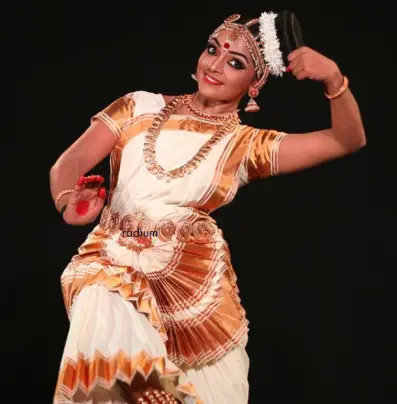List of Top 8 classical dance form in India
India is a mosaic of diverse cultures, proudly showcases a rich tapestry of dance forms, each a testament to its cultural opulence. As we traverse this nation, we delve into the enchanting narratives woven into the fabric of each state’s distinctive dance form. These dances transcend mere movement; they narrate stories, encapsulate cultural significance, and resonate with rhythmic brilliance. Unveiling the soul of India’s dance heritage, our journey unfolds the unique expressions, footwork intricacies, and emotive tales that encapsulate the essence of this artistic legacy. Join us on this odyssey, where every dance becomes a chapter, every step a verse, in the captivating saga of India’s cultural diversity.
List of Top 8 classical dance form in India
Kuchipudi
Kuchipudi dance is a distinguished form of classical dance in India holds its roots in the village of Kuchipudi, Andhra Pradesh. Originally it appeared as a dance drama uplifted by the ancient Hindu Sanskrit text Natya Shastra.
Odissi
Odissi, also known as Orissi in ancient literature, stands as a prominent ancient Indian classical dance form that originated in the sacred precincts of Odisha, an eastern coastal state in India. Rooted in the rich cultural tapestry of the region, Odissi flourished within the temple environs, predominantly performed by women.
Kuchipudi
Kuchipudi dance is a distinguished form of classical dance in India holds its roots in the village of Kuchipudi, Andhra Pradesh. Originally it appeared as a dance drama uplifted by the ancient Hindu Sanskrit text Natya Shastra. It was associated with religious faith, temples and nomad bards. Copper inscriptions from the 10th century and texts like Machupalli Kaifat in the 15th century attest to its early existence.
Tirtha Narayana Yati, a sanyassin, and his disciple Siddhendra Yogi played pivotal roles in systematizing Kuchipudi in the 17th century. Initially Krishna-oriented in Vaishnavism, it was known as Bhagavata Mela in Thanjavur. Traditionally, it featured all-male troupes, with dancers portraying male roles in Agnivastra (Bagalbandi) and female roles in saris. The performance typically commences with an invocation, introducing each costumed actor and progressing through a preliminary dance (dharavu), pure dance (nritta), and expressive storytelling (nritya), accentuated by rhythmic hand gestures. Accompanied by Carnatic music in Telugu, instruments like mridangam, cymbals, veena, flute, and tambura add a melodic layer. From its Krishna-centric origins, Kuchipudi has transcended borders, gaining popularity globally through captivating performances.
Odissi
Odissi, also known as Orissi in ancient literature, stands as a prominent ancient Indian classical dance form that originated in the sacred precincts of Odisha, an eastern coastal state in India. Rooted in the rich cultural tapestry of the region, Odissi flourished within the temple environs, predominantly performed by women. Its essence lies in narrating religious stories and spiritual concepts, notably those associated with Vaishnavism, through the seamless integration of music, dance, and expressive elements.
The dance’s theoretical underpinnings find their roots in the ancient Sanskrit text Natya Shastra, evidenced by the intricate dance poses adorning the sculptures of Kalingan temples. Suppressed during British rule, Odissi experienced a revival and expansion post-Independence, fueled by Indian protests against cultural subjugation.
Odissi, a dance-drama genre, intricately weaves tales and spiritual messages from Hindu texts, employing symbolic costumes, body movements, and expressive gestures. The repertoire includes invocation, pure dance, expressive dance, dance drama, and a climax symbolizing spiritual release. Odissi exists in two major styles: one, perfected by women, focuses on solemn temple dances (maharis), while the other, practiced by boys disguised as girls (gotipuas), incorporates athletic and acrobatic elements for festive occasions.
In contemporary times, Odissi productions by Indian artists have embraced experimentation, cultural fusion, diverse themes, and plays, showcasing the dance form’s adaptability and enduring allure. An interesting historical note is that Odissi was the sole Indian dance form featured in Michael Jackson’s 1991 hit single “Black or White.”
Bharatanatyam
Emerging from the cultural soil of Tamil Nadu, Bharatanatyam stands as a revered ancient classical dance acknowledged by the prestigious Sangeet Natak Akademi. Rooted in Hinduism it explores religious themes specifically those of Shaivism. Silappatikaram, a 2nd-century Tamil epic provides early references while 6th to 9th-century temple sculptures indicate a refined dance form. Renamed Bharatanatyam in 1932, it holds the distinction of being Tamil Nadu’s state dance.
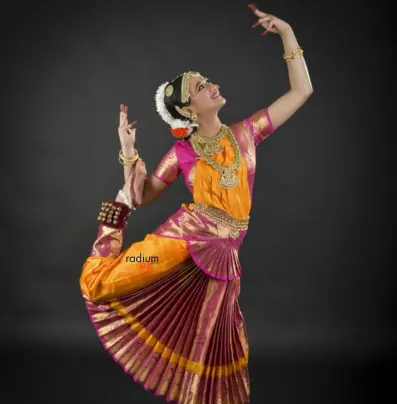
Distinctive dance techniques, known as “banis,” characterize Bharatanatyam. These styles, named after gurus or villages, feature fixed upper torsos, bent legs, and expressive hand gestures. With its origin in Natya Shastra, the dance encompasses nrita (pure dance), nritya (expressive solo dance), and natya (group dramatic dance).
Historically confined to Hindu temples, Bharatanatyam faced colonial bans in 1910, but resilient efforts revived it. E. Krishna Iyer and Rukmini Devi Arundale, in 1932, proposed renaming it to grant respect. Despite Western influence, Bharatanatyam’s revival in the 20th century, led by artists like Arundale, aimed to reclaim cultural heritage, resisting colonial impositions and moral judgments.
This classical dance, featuring solo or group performances, conveys stories from epics, embodying the essence of Natya Shastra and other ancient texts. Adorned in colorful saris, dancers use intricate hand and facial gestures to narrate legends and spiritual ideas, making Bharatanatyam a rich tapestry of India’s cultural and artistic legacy.
Sattriya
Originating from Assam the Sattriya dance, with roots tracing back to the 15th century AD is a cultural gem introduced by the revered Vaishnav saint, Mahapurusha Sankaradeva. This dance form acts as a vessel for imparting mythological teachings, embodying the spiritual and devotional essence of Assamese culture. Recognized by the Sangeet Natak Akademi as a classical dance in 2000, Sattriya showcases a unique blend of dance and music.
The musical accompaniment known as Borgeet, resonates with Assamese melodies enhancing the emotive storytelling of the dance. Central to Sattriya are the performances of ‘ankiya bhaona’ and Ojapali, where the singer often the lead dancer engages in both acting and singing, accompanied by a group of cymbal-playing dancers.
Two notable figures, Sharodi Saikia and Guru Jatin Goswami, have left an indelible mark as prominent Sattriya dance performers in India. Their artistry not only preserves the historical significance of Sattriya but also contributes to its continued evolution as a revered classical dance form, embodying the cultural richness of Assam.
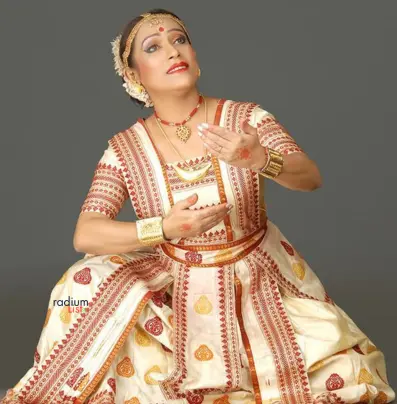
Manipuri
Originating from Manipur in North East India, Manipuri dance is a captivating classical form deeply rooted in Vaishnavism, predominantly portraying the divine love between Radha and Krishna notably through the enchanting ‘Ras Leela.’ This dance is a cultural amalgamation showcasing influences from both Indian and South-East Asian traditions. Primarily performed during Hindu festivals the artists referred to as ‘Gandharvas’ draw inspiration from Hindu epics such as the ‘Ramayana’ and ‘Mahabharata.’
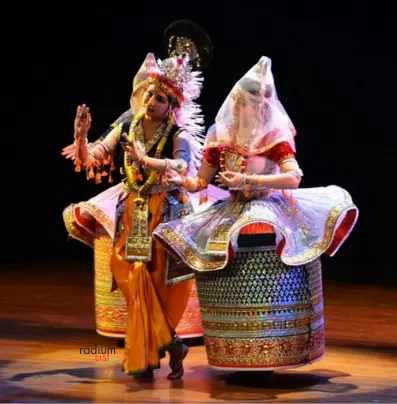
Distinctive costumes add to the allure of Manipuri dance, with male dancers adorned in ‘dhoti’ or ‘dhora,’ and female dancers in ‘Potloi’ reminiscent of traditional Manipuri bridal attire. The choreography intricately weaves tales of Radha and Krishna, with a unique focus on depicting the changing seasons.
Known for its gracefulness, Manipuri dance stands out with gentle and lyrical movements, creating a visual poetry that resonates with spectators. Renowned Manipuri dancers like Guru Bipin Singh, Darshan Jhaveri, and the talented sisters Suverna, Nayana, Ranjana, and Devyani Challi, along with Charu Mathura, have significantly contributed to the prominence and richness of this classical dance form. Their artistry transcends cultural boundaries, making Manipuri dance a timeless expression of love and devotion.
Kathakali
The origins of Kathakali, a classical dance form, remain somewhat ambiguous. While the fully developed style emerged around the 17th century, its roots are intertwined with the temple and folk arts of the southwestern Indian peninsula. Influences from Krishnanattam and religious dramas under the Zamorin of Calicut kingdom can be traced back to at least the 1st millennium CE. Unlike other classical Indian dances originating in temples and monastic schools, Kathakali’s structure and evolution unfolded in the courts and theaters of Hindu principalities.
A Kathakali performance, akin to other classical dance arts in India, harmonizes music, vocal performances, choreography, and intricate hand and facial gestures to convey profound ideas. What sets Kathakali apart is its incorporation of movements from ancient South Indian martial arts and athletic traditions, adding a unique dimension to its expression.
The traditional themes explored in Kathakali performances encompass folk tales, religious legends, and spiritual narratives derived from Hindu epics and the Puranas. The vocal component is traditionally delivered in Sanskritised Malayalam. Notably, modern Kathakali troupes have embraced innovation by including women artists and adapting Western stories, including works by Shakespeare. This dynamic art form has also ventured into new realms, marking its debut in Christian narratives in Kerala, showcasing the evolving and inclusive nature of Kathakali.
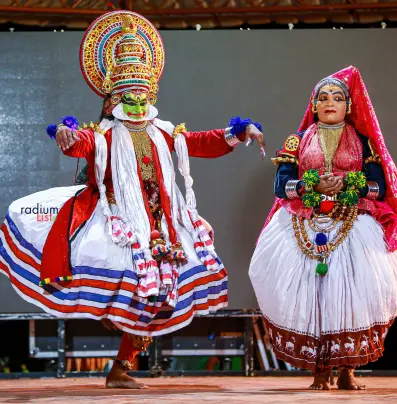
Kathak
Kathak holds a distinguished place among India’s classical dance traditions, Hailing from Uttar Pradesh. The term Kathak finds its roots in Sanskrit, specifically in “Kathakar,” denoting a storyteller or one skilled in the art of narrating tales. These storytellers known as Kathakars were natural wanderers intricately stirring tales from epics and mythology through a fascinating fusion of dance, song and music.
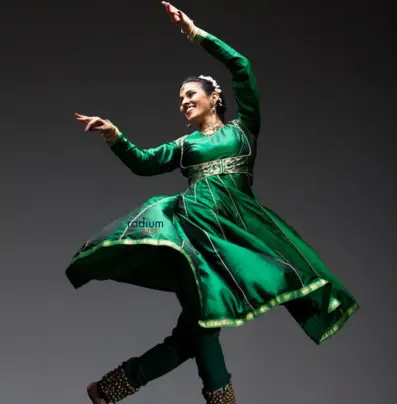
Kathak unfolds narratives through intricate hand movements, expressive footwork, body flexibility and notably facial expressions. With a rhythmic beat, it accommodates various taals evolving during the Bhakti movement incorporating stories of Hindu deity Krishna. Mughal emperors patronized Kathak during their rule infusing Persian elements into this dance form.
Distinct gharanas, namely Jaipur, Banaras, Raigarh and Lucknow characterize Kathak. Jaipur emphasizes foot movements, while Banaras and Lucknow focus on graceful hand gestures and facial expressions. The dance style emphasizes rhythmic footwork adorned with small bells (Ghungroo), with storytelling conveyed through a rich vocabulary of arm gestures, facial expressions and body movements.
Kathak a surviving oral tradition that transitioned through Mughal influences experienced a decline in the colonial era, and witnessed a revival post-independence contributing to India’s cultural rediscovery and national identity.
Mohiniyattam
Mohiniyattam, hailing from Kerala, India, is a classical dance form with its roots embedded in the ancient Hindu text, Natya Shastra. Named after Mohini, the enchanting female avatar of Vishnu, known for using her feminine charm to aid the devas against the asuras, Mohiniyattam epitomizes the Lasya style described in Natya Shastra—delicate, filled with eros, and distinctly feminine.
Traditionally a solo performance reserved for women after rigorous training, contemporary times have seen men also embrace this art. The dance, accompanied by Carnatic-style music, involves singing and acting out a play. The recitation is either by a separate vocalist or the dancer, using the unique Malayalam-Sanskrit hybrid, Manipravalam.
While the term first appears in the 16th-century text Vyavaharamala, its origins trace back further. In the 18th century, Mohiniyattam faced criticism and was unjustly associated with the Devadasi system during the colonial British Raj. Subsequent bans from 1931 to 1938 were met with protests, leading to a partial repeal in 1940. Despite socio-political challenges, Kerala, particularly poet Vallathol Narayana Menon, played a pivotal role in the revival and reconstruction of Mohiniyattam, preserving its cultural significance.
